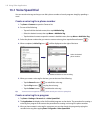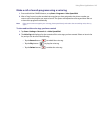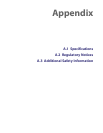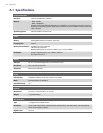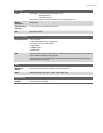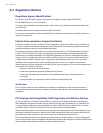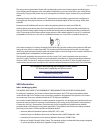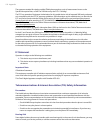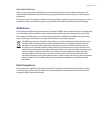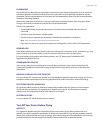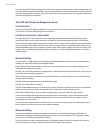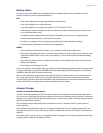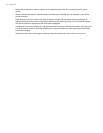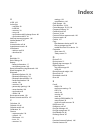
150 Appendix
The exposure standard for wireless mobile CDMA phone employs a unit of measurement known as the
Specific Absorption Rate, or SAR. The SAR limit set by the FCC is 1.6 W/kg*.
The FCC has granted an Equipment Authorization for this model device with all reported SAR levels evaluated
as in compliance with the FCC RF exposure guidelines. SAR information on this model device is on file with the
FCC and can be found under the Display Grant section of https://gullfoss2.fcc.gov/prod/oet/cf/eas/reports/
GenericSearch.cfm after searching on FCC ID: NM8VOGU100. Additional information on Specific Absorption
Rates (SAR) can be found on the Cellular Telecommunications & Internet Association (CTIA) Web-site as
http://www.phonefacts.net.
Additional information on Specific Absorption Rates (SAR) can be found on the Cellular Telecommunications
& Internet Association (CTIA) Web-site as http://www.phonefacts.net.
* In the U.S. and Canada, the SAR limit for mobile CDMA phone used by the public is 1.6 Watts/kg (W/kg)
averaged over one gram of tissue. The standard incorporates a substantial margin of safety to give additional
protection for the public and to account for any variations in usage.
Normal condition only to ensure the radiative performance and safety of the interference. As with other
mobile radio transmitting equipment, users are advised that for satisfactory operation of the equipment and
for the safety of personnel, it is recommended that no part of the human body be allowed to come too close
to the antenna during operation of the equipment.
IC Statement
Operation is subject to the following two conditions:
1. This device may not cause interference; and
2. This device must accept any interference, including interference that may cause undesired operation of
the device.
Important Note
IC Radiation Statement:
This equipment complies with IC radiation exposure limits set forth for an uncontrolled environment. End
users must follow the specific operating instructions for satisfying RF exposure compliance.
This Class B digital apparatus complies with Canadian ICES-003.
Telecommunications & Internet Association (TIA) Safety Information
Pacemakers
The Health Industry Manufacturers Association recommends that a minimum separation of six inches be
maintained between a handheld wireless phone and a pacemaker to avoid potential interference with the
pacemaker. These recommendations are consistent with the independent research by and recommendations
of Wireless Technology Research. Persons with pacemakers:
•
Should ALWAYS keep the phone more than six inches from their pacemaker when the phone is turned ON.
• Should not carry the phone in a breast pocket.
• Should use the ear opposite the pacemaker to minimize the potential for interference. If you have any
reason to suspect that interference is taking place, turn the phone OFF immediately.
Hearing Aids
Some digital wireless phones may interfere with some hearing aids. In the event of such interference, you may
want to consult your service provider, or call the customer service line to discuss alternatives.



